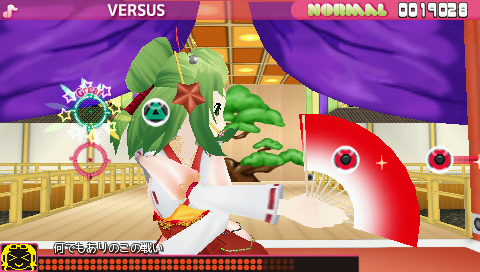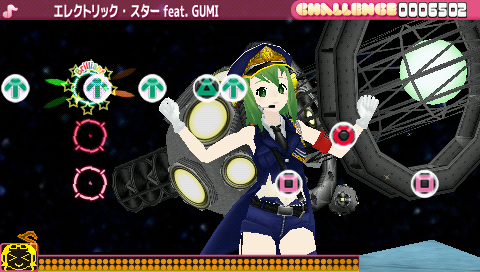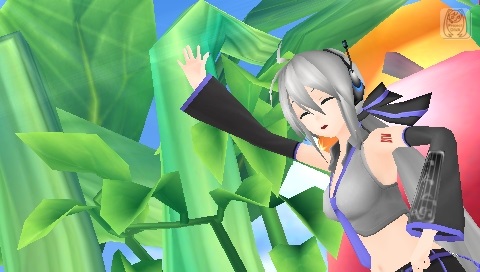EDITOR'S NOTE:
Oh. More vocaloids. Y-yay.
Anyway, we finally got around to modding our PSP, and by 'we got around to it' what we actually mean is 'this article was started so long ago that we thought it was going to be the first PSP article with our home-grown screenshots so we made a song and dance about it, but Koloomn beat it by several months'. This means that almost all these screenshots are our own, with one exception- the third one, of GUMI checking her mail, comes to us from the Playstation page for the game (a distinct entity, for the record, from the Playstation Network store website) because we had the perfect caption for it and it cracked us up. Thank you for your time.
Hilariously, this game has an equivalent of the DIVA Room from Project DIVA... So we'll be ignoring it again! Fantastic!
This is the never-ending story of how I became the worst Vocaloid fan in the world.
For this month's Lesson in scrub-level Vocaloidin', let's talk about GUMI.
As I briefly mentioned in the opening spiel of Project DIVA F's review, Crypton Future Media's Vocaloids are not the only 'oids out there. Many other voicebanks have been created by other companies getting in on the act, and one of the bigger competitors is GUMI. She's the cover-girl for INTERNET Co.'s Megpoid software, released in 2009 and based on Vocaloid3 technology, with a voice bank from Megumi Nakajima, best known as the voice actress for Ranka Lee from Macross Frontier (huh, what's that? GUMI looks suspiciously similar to Ranka? Err, nah, 'course not, it's just a coincidence).I'm hardly one to judge her popularity (this is scrub-level Vocaloidin', remember), she's certainly one of the bigger non-Crypton Vocaloids our there, to the point where she's also the first non-Crypton 'oid to have her own video game (IA would take a bit longer to get there, but got one on the Vita we may see another time). Sure, she made a guest appearance in Sega's 3DS Vocaloid games, Project mirai 1, 2 and Remix (The full title is of the first game is Hatsune Miku and Future Stars Project mirai- GUMI is the 'future star' of the title) but her appearance was very limited in the first game (she only appears in two animated songs, so she can't be used in any others). You don't want that, surely! You want a proper GUMI game, one where she's the star, don't you? That's what Megpoid the Music♯ (that's a sharp, not a hash) is, then. A rhythm game with just GUMI.
When this was announced, things were looking a bit weird for two reasons:
#1 - It was coming out on the PSP (cheap development, I guess?) in the space-year 2013.
#2 - This wasn't coming from an established company, but instead ParaPhray, and this would be their very first game.
(It would also prove to be their final game, as they have done nothing since.)
But hey, think positive and all that, right? Can't judge a game just because the preview videos have tons of clipping, yeah?
!['Mego-mego-mee~! I may look like I'm out of Project DIVA, but this game is much worse! Mego-mego-me~~!'
[YOU COULDN'T DO IT, COULD YOU
NOT ONE GOD-DAMN RHYTHM GAME ARTICLE WITHOUT A NICO JOKE
- Ed]
And I'd do it again just to spite you!](images/megpoidmusic/megpoidmusic2.png)

Nope. This one's a swing and a miss.
Rather than Project DIVA's freeform 'notes appear from all around, destroy them all!' approach, Megpoid the Music♯ has a more traditional 'here's a column of notes, they're comin' atcha fast!' style. Just replace the columns with rows, with big target circles at the end. The PSP's in widescreen format, of course, so using rows is a bit more sensible (see also: the K-ON! PSP game). As GUMI dances to the music in the background, notes appear from the right- either normal notes or 'hold' notes- so hit 'em when they're in the target marker. Hit notes, get down. That's pretty much it, as you'd expect. However, much like Project DIVA 2nd was a learning experience for me about rhythm games (the lesson was 'give me feedback'), my experience with Megpoid the Music♯, taught me why games with similar note systems like beatmania and Guitar Hero do things the way they do- it's not confusing. To take the example of beatmania, something I will probably regret because I'm even worse at that series than I am Project DIVA, depending on the version you're playing, it has a certain number of buttons (keyboard keys) and a turntable, but the way they're laid out on the screen is exactly how they're laid out in real life. Each note column in the game deals with that key on the keyboard, and only that note. You know where I'm coming from, right? The column on the far-left is for the key on the far-left! It's intuitive, no? In fact, one of the better arcade rhythm games in recent times- the excellent Chunithm, which I was very fortunate to play briefly during my Japan trip in 2015- took this idea to its logical end, with a keyboard controller that you don't even need to hit individual notes on- just notes in the target area, usually a spread of about 3 to 4.


However, while Megpoid the Music♯'s rows (one in Easy, two in Normal, three in Challenge and the full four in Expert) sound pretty standard- you would assume one row per face button- each row is actually for a face button and its equivalent d-pad direction (Up, in Triangle's case, for instance). When dealing with two rows in the early songs, this is OK. Later songs, and anything with three or more rows, gets confusing. A note on any row can be one of two buttons, and this wouldn't be a problem if you could very easily tell which one's which. However, the game's pastel colour scheme can actually make it difficult to tell the difference in the heat of battle- even if face notes have a black background and directions have white backgrounds, the contrast between them simply isn't strong enough. While these look fine in static screenshots, when they're moving and blurring it's much harder to distinguish them. So, you're gonna find yourself pressing the wrong button solely out of instinct- you'll know which row it is, but just go for the wrong one instantly. The double-notes- only ever Triangle + Down, Cross + Up, Square + Right or Circle + Left, at least- are initially a problem too, but the trick is to look for the direction first so you'll know which face button needs pressing. Even so, the game's presentation does hurt the readability of the notes, a problem I've not had with other portable rhythm games (so far). Practice helps, but it still doesn't feel nearly as natural as others in the genre, and some of the notecharts are so haphazard that it just feels like chaos, like someone switched some kind of randomised notes option on and forgot to switch it off.


The notes are just one problem though, as there's plenty more where that came from. The biggest one is the ranking system for the game makes no sense. The closest comparison I can come up with is Guitar Hero's Rock Meter- your health meter at the bottom of the screen will have a flashing yellow line at the bottom if you're going to get a passing grade (Well, Excellent, Wonderful and Perfect), and it won't be there if you're going to fail (Bad). The problem here is similar to the one I had with Project DIVA 2nd- it's really hard to get feedback on how you're doing. Here, it's much worse because it's based entirely on whether the bar is flashing at the end of a song. On more than one occasion (I'm thinking Ten Faced in particular) I aced a song for 80% of its length then fluffed it up at the very end- the last 6 or so notes- and I got a Bad. Once this happened on the final pair of notes. If you watch the bar as you play, it's like a teeter-totter flipping wildly between PASS and FAIL. It's so flimsy and uncertain that grasping how well you're doing is just impossible, and this is further compounded by the construction of the notecharts themselves, with about 80% of songs on Challenge and above starting with a very difficult set of notes, then settling down, then ramping the difficulty up again for the final stretch. The songs feel very uneven as a result, and that's compounded by their brevity- most songs have been cut down to just over a minute or so, and the edits are pretty obvious.
The other serious issue with Megpoid the Music♯ is, much like the Love Live! Vita game, this absolutely feels like a game that was kicked out the door without enough care and attention. This is mostly evident in the technical issues plaguing it, such as the jarring load times. I know the PSP isn't exactly great at loading stuff quickly, but Megpoid the Music has, by far, the worst loading times I've ever seen on the system, and it's not just waiting around that's a problem. Simply navigating the song select menu is a trial because it will grind to a halt to load a sample every single time you move from one song to another and you can't even flip through them quickly as the names disappear while it's loading. Changing costumes also takes forever, as does loading to get to the songs themselves. Worse than anything though, the game will stutter and splutter during heavy note patterns in-game, and while this is something I complained about in the Project DIVA games from F onwards, it is a lot worse and far more distracting here. Basically, it's a shambles that feels actively difficult to pick up and play, a disaster for a portable game.


Speaking of the Love Live! Vita game, it probably says a lot that there's far more to say about that game than this one. Love Live! Vita may have not been successful in what it was trying to do, and it too had a little stuttering and spluttering here and there, but at least it was pleasant enough to actually play. I blasted through that a lot quicker than I expected, but Megpoid the Music♯ took far, far longer, and not just because of the load times, but because I could only play a few songs at a time before getting fed up with it. The technical issues, utterly baffling and unfair passing grade system, and most of all the poor readability of the thing made it a total slog, where I just wanted to get to those end credits and have done with it. The sad thing is, with more time and care put into it, this really could've been a decent alternative to Project DIVA. GUMI herself has a great model as well as some cute costumes (even if many of them are palette-swaps of one another) and, most critically, the setlist is very, very good. Songs from well-regarded Vocaloid producers like samfree, Hachioji-P, OSTER project and DECO*27 show up, and while perhaps there's not as wide a selection of genres as other rhythm songs, the songs that are here are excellent (favourites include KILLER LADY and Electric Star).
Sadly, a solid setlist can't save a rhythm game if the mechanics aren't up to snuff, and Megpoid the Music♯ is absolutely not up to the task. Just remembering how much I wanted to stop playing it and never touch it again made it clear, this is a one-star game and it gives me no pleasure in typing that. The one concession I will give it is, if you're a big GUMI fan, you might get something out of this given how solid the setlist is, but you would have to have far, far more patience than I, and if you're expecting a viable Project DIVA competitor, or just a solid rhythm game in general, this is absolutely not it, not even close. The poor thing just wasn't in the oven long enough, so bless you, GUMI, but you've failed the audition, now go back to singing about being in love with a fire extinguisher (yes, that's real).

For trying its best (I mean, probably), Megpoid the Music♯ is awarded...

In a sentence, Megpoid the Music♯ is...
Only slightly better than Puyo Puyo DA!, though this is damning with faint praise.
You know, I can't help but feel like there's something missing.
This page just doesn't feel right, you know?
Something very important is... Ah, wait, I got it.

There we go. Now it's a proper Vocaloid page!
[GUMI is a Megpoid, while Haku is a derivative Vocaloid. You've failed, and on something you're supposed to be a nerd about. For shame, doc!
- Ed]
So you do know your Megpoids from your Vocaloids. You like this stuff more than you let on, Ed!
[No I don't, it's just... Uh... Aww, shit.]
... Anyway, here's a translation guide if you insist on playing this for yourself.
Better luck next time, GUMI.
!['Mego-mego-mee~! I may look like I'm out of Project DIVA, but this game is much worse! Mego-mego-me~~!'
[YOU COULDN'T DO IT, COULD YOU
NOT ONE GOD-DAMN RHYTHM GAME ARTICLE WITHOUT A NICO JOKE
- Ed]
And I'd do it again just to spite you!](images/megpoidmusic/megpoidmusic2.png)









